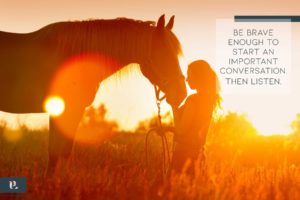An organization’s ability to learn faster and better than its competitors is a strategic competitive advantage. So why do so many training programs fail? We’ve all attended ineffective programs and then promptly forget everything we’ve learned and carry on, business as usual. What are the differences between effective, engaging training programs that lead to desired behavior change and those that don’t?
“Learning is a biological event. It takes place in the brain and body of the learner.”
James E Zull
Learning takes place when new connections are made in the brain. New neural pathways are forged. Research indicates that learning happens in a cycle and involves our bodies, emotions, our senses as well as our cognition. The cycle of learning begins most powerfully with a concrete experience; something happens that engages our senses and emotions. We are motivated to learn. Next, we reflect on that experience – what just happened and what does it mean in the context of what I already know? We filter this new experience through past experience and knowledge. Next, comes abstract conceptualization –we begin to form a hypothesis, and take in new information. The final step in the cycle is doing, actively experimenting with what we’ve just learned. We tinker and take action to begin to make the learning practical. We plan for how we can use this new learning in the real world.
Let’s use learning how to make Moroccan chicken as an example of the learning cycle in action. Imagine yourself in a restaurant eating delicious Moroccan chicken. You taste the spices and experience the aroma. You take in the color and texture of the dish. Then you begin to reflect on what makes it so good. Which spices do you recognize? What have you eaten before that resembles this dish? You then decide to cook Moroccan chicken at home. You recall the experience of what it tasted like and hypothesize about which spices and ingredients to use. After buying the ingredients, you experiment with re-creating the dish. You taste it, reflect on how close it is to the original, refine your hypothesis and then try again – the cycle of learning.
Here are some things to keep in mind when designing or evaluating a training program:
- Does the program engage the learner from the start with a concrete experience? Is there an opportunity for learners to explore their feelings and insights and collaborate with others? Does it connect to what they already know in some way?
- From the learners perspective, does the program answer the question, “Why is this important?”
- Is the content accurate, organized and delivered using stories, metaphors, humor and compelling visuals?
- Are there activities that allow the learners to tinker with the learning and practice?
- Are learners given an opportunity to self-evaluate their learning and refine it for application in the real world?
- Is there a mix of somatic (moving and doing), auditory (talking and hearing), visual (images) and intellectual (problem-solving and reflecting) activities?
- Is there follow-up after training to see how learners are doing and to reinforce the learning?
Quality training is a creative, whole-brain experience that engages the learner on multiple levels.



